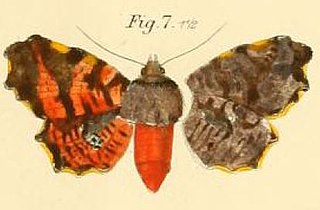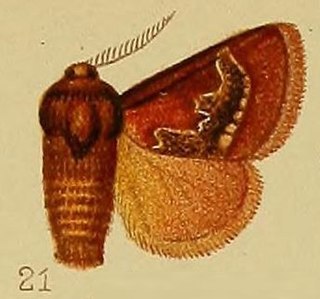
Earias is a genus of moths in the monotypic subfamily Eariadinae of the family Nolidae. The genus was erected by Jacob Hübner in 1825. Species are found throughout Europe, Africa, Asia and Australia, some being agricultural pests such as bollworms.
Dolgoma is a genus of moths in the family Erebidae. The genus was erected by Frederic Moore in 1878.

Serrodes is a genus of moths in the family Erebidae first described by Achille Guenée in 1852.
Scopula addictaria is a moth of the family Geometridae. It was described by Francis Walker in 1861. It is found in Sri Lanka.

Thalassodes quadraria is a species of moth of the family Geometridae first described by Achille Guenée in 1857. It is found in Africa south of the Sahara and in India and Sri Lanka.

Eutelia geyeri is a moth of the family Noctuidae first described by Rudolf Felder and Alois Friedrich Rogenhofer in 1874. This species is found in India, Sri Lanka, China and Japan, as well as from Africa, where its presence had been reported from Lesotho and Seychelles.

Banisia myrsusalis, the sapodilla borer or sapota midrib folder, is a species of moth of the family Thyrididae. It was described by Francis Walker in 1859 and is found in North America, Brazil, Australia, southern Asia and Africa.
Dolgoma cribrata is a moth of the family Erebidae first described by Otto Staudinger in 1887. It is found in eastern Asia, more specifically Russia, China, Korea and Japan.
Dolgoma fukienica is a moth of the family Erebidae. It is found in Fujian in south-eastern China.
Dolgoma oblitterans is a moth of the family Erebidae first described by Rudolf Felder in 1868. It is found from the Himalayas, Sri Lanka to Yunnan. There is also a record from Tanzania.
Dolgoma ovalis is a moth of the family Erebidae. It is found in Shaanxi, China.
Dolgoma recta is a moth of the family Erebidae. It is found in Thailand.
Dolgoma reticulata is a moth of the family Erebidae. It is found in the Himalayas.
Dolgoma nigrocribrata is a moth of the family Erebidae. It is found in Guangdong, China.

Dysodia is a genus of moths of the family Thyrididae. It was described by James Brackenridge Clemens in 1860.

Miresa is a genus of moths in the family Limacodidae described by Francis Walker in 1855.
Eilema griveaudi is a moth of the subfamily Arctiinae. It was described by Hervé de Toulgoët in 1960. It is found in eastern Madagascar.
Eilema punctifera is a moth of the subfamily Arctiinae first described by George Hampson in 1893. It is found in Sri Lanka.

Indarbela is a genus of moths in the family Metarbelidae described by Thomas Bainbrigge Fletcher in 1922.
Surattha invectalis is a moth in the family Crambidae. It was described by Francis Walker in 1863. It is found in Sri Lanka, India, Java, Indonesia, Myanmar, and Kenya.






